LAWS6003B - High Court Submission: Barton v The Queen Case Analysis
VerifiedAdded on 2023/06/07
|9
|3824
|146
AI Summary
This document presents an appellant's submission to the High Court of Australia in the case of Anthony Barton v The Queen. The case concerns Barton's conviction for murder, along with co-accused David Sager, and focuses on issues of procedural fairness and the application of s 6(3) of the Criminal Appeal Act, 1912 (NSW). The submission argues that the intermediate court of appeal erred in making 'aggravated' and 'adverse factual findings' different from those of the sentencing judge, particularly regarding the appellant's intent and the foreseeability of a murderous assault within the context of a joint criminal enterprise. The document references key legal precedents, including Kentwell v The Queen and Betts v The Queen, and emphasizes the appellant's lesser moral culpability compared to the principal offender, Sager. The submission contends that Barton's conviction should be overturned or a lesser sentence warranted based on these arguments. Desklib provides access to this and other solved assignments to aid students in their studies.
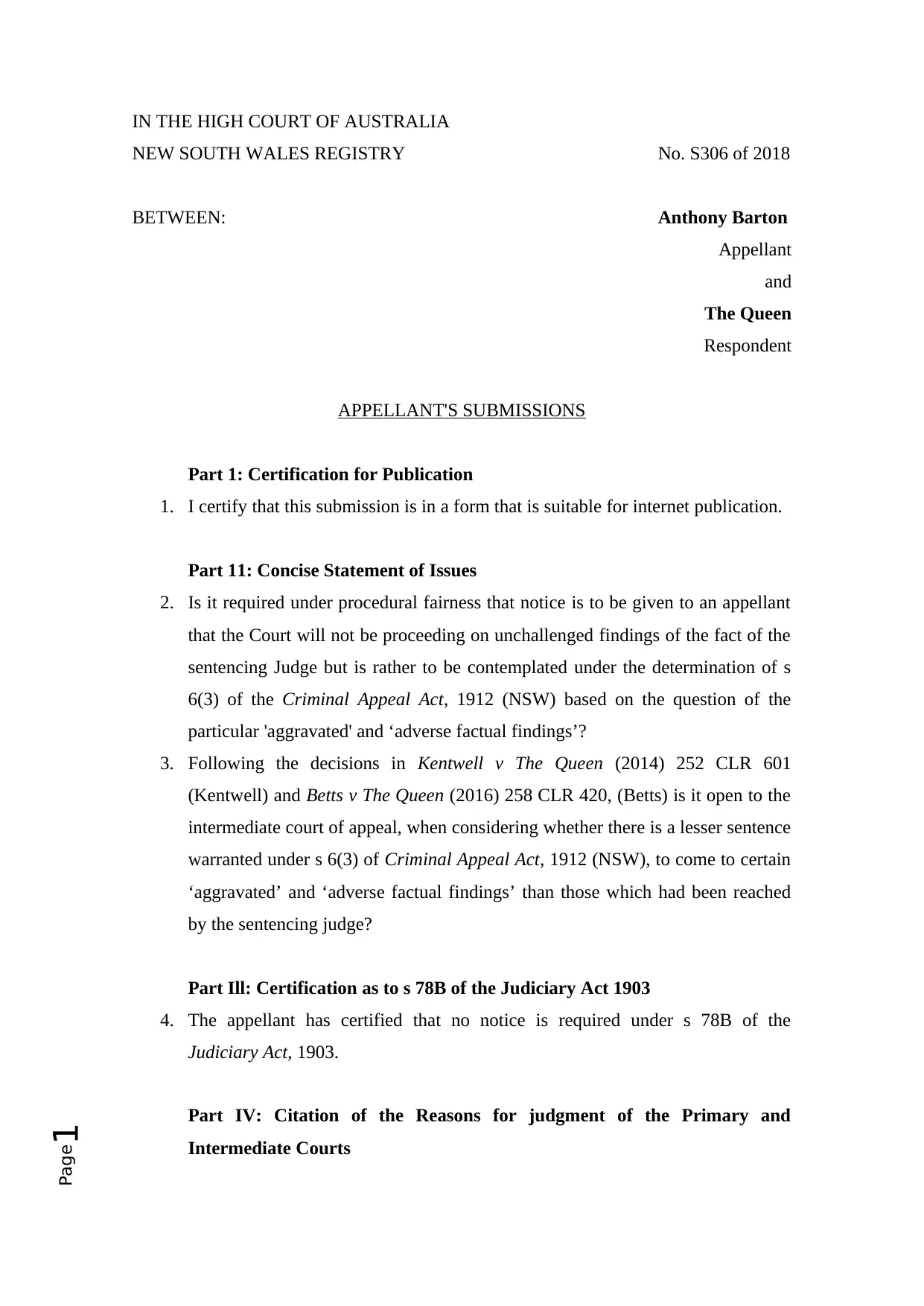
Page1
IN THE HIGH COURT OF AUSTRALIA
NEW SOUTH WALES REGISTRY No. S306 of 2018
BETWEEN: Anthony Barton
Appellant
and
The Queen
Respondent
APPELLANT'S SUBMISSIONS
Part 1: Certification for Publication
1. I certify that this submission is in a form that is suitable for internet publication.
Part 11: Concise Statement of Issues
2. Is it required under procedural fairness that notice is to be given to an appellant
that the Court will not be proceeding on unchallenged findings of the fact of the
sentencing Judge but is rather to be contemplated under the determination of s
6(3) of the Criminal Appeal Act, 1912 (NSW) based on the question of the
particular 'aggravated' and ‘adverse factual findings’?
3. Following the decisions in Kentwell v The Queen (2014) 252 CLR 601
(Kentwell) and Betts v The Queen (2016) 258 CLR 420, (Betts) is it open to the
intermediate court of appeal, when considering whether there is a lesser sentence
warranted under s 6(3) of Criminal Appeal Act, 1912 (NSW), to come to certain
‘aggravated’ and ‘adverse factual findings’ than those which had been reached
by the sentencing judge?
Part Ill: Certification as to s 78B of the Judiciary Act 1903
4. The appellant has certified that no notice is required under s 78B of the
Judiciary Act, 1903.
Part IV: Citation of the Reasons for judgment of the Primary and
Intermediate Courts
IN THE HIGH COURT OF AUSTRALIA
NEW SOUTH WALES REGISTRY No. S306 of 2018
BETWEEN: Anthony Barton
Appellant
and
The Queen
Respondent
APPELLANT'S SUBMISSIONS
Part 1: Certification for Publication
1. I certify that this submission is in a form that is suitable for internet publication.
Part 11: Concise Statement of Issues
2. Is it required under procedural fairness that notice is to be given to an appellant
that the Court will not be proceeding on unchallenged findings of the fact of the
sentencing Judge but is rather to be contemplated under the determination of s
6(3) of the Criminal Appeal Act, 1912 (NSW) based on the question of the
particular 'aggravated' and ‘adverse factual findings’?
3. Following the decisions in Kentwell v The Queen (2014) 252 CLR 601
(Kentwell) and Betts v The Queen (2016) 258 CLR 420, (Betts) is it open to the
intermediate court of appeal, when considering whether there is a lesser sentence
warranted under s 6(3) of Criminal Appeal Act, 1912 (NSW), to come to certain
‘aggravated’ and ‘adverse factual findings’ than those which had been reached
by the sentencing judge?
Part Ill: Certification as to s 78B of the Judiciary Act 1903
4. The appellant has certified that no notice is required under s 78B of the
Judiciary Act, 1903.
Part IV: Citation of the Reasons for judgment of the Primary and
Intermediate Courts
Paraphrase This Document
Need a fresh take? Get an instant paraphrase of this document with our AI Paraphraser
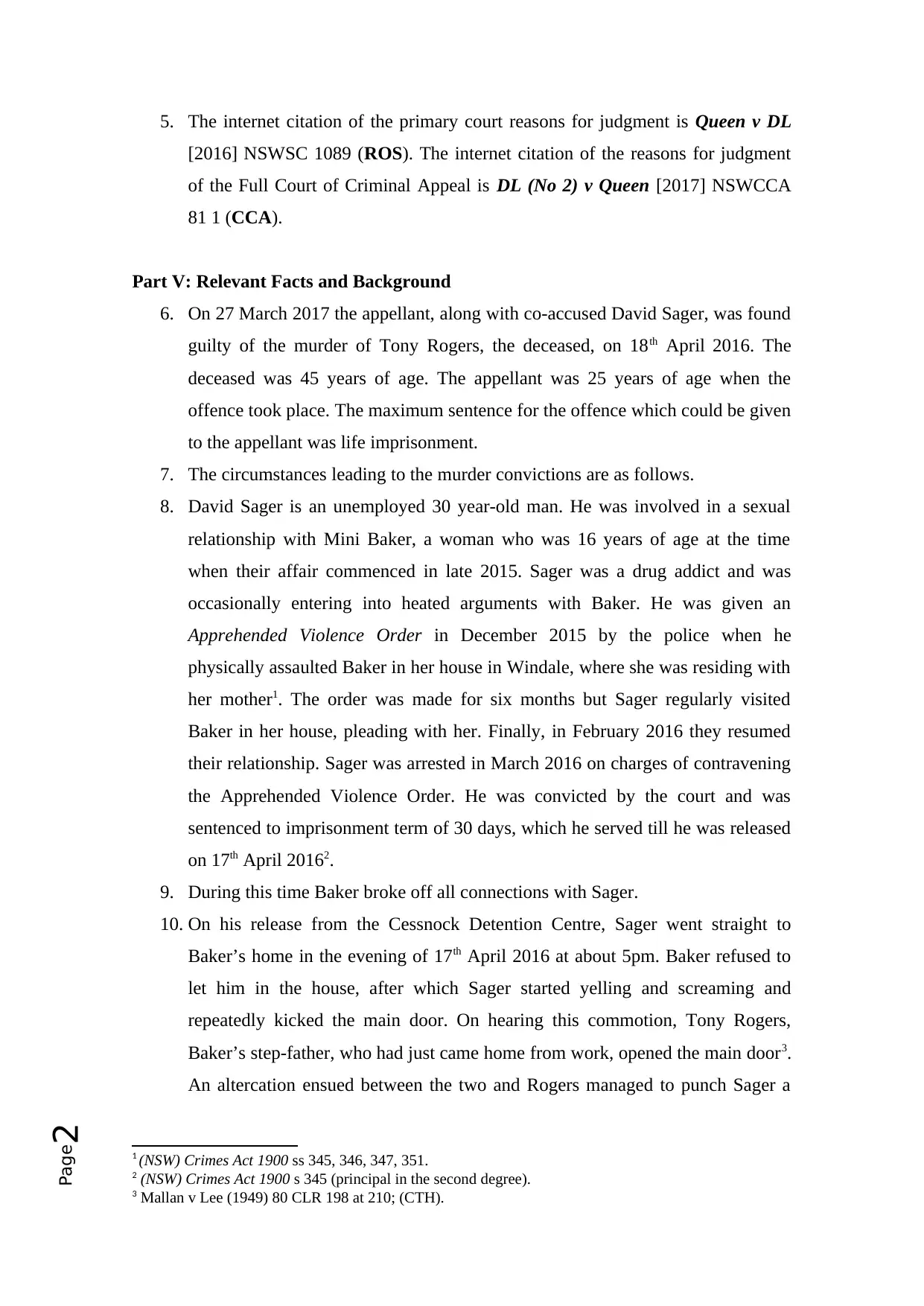
Page2
5. The internet citation of the primary court reasons for judgment is Queen v DL
[2016] NSWSC 1089 (ROS). The internet citation of the reasons for judgment
of the Full Court of Criminal Appeal is DL (No 2) v Queen [2017] NSWCCA
81 1 (CCA).
Part V: Relevant Facts and Background
6. On 27 March 2017 the appellant, along with co-accused David Sager, was found
guilty of the murder of Tony Rogers, the deceased, on 18th April 2016. The
deceased was 45 years of age. The appellant was 25 years of age when the
offence took place. The maximum sentence for the offence which could be given
to the appellant was life imprisonment.
7. The circumstances leading to the murder convictions are as follows.
8. David Sager is an unemployed 30 year-old man. He was involved in a sexual
relationship with Mini Baker, a woman who was 16 years of age at the time
when their affair commenced in late 2015. Sager was a drug addict and was
occasionally entering into heated arguments with Baker. He was given an
Apprehended Violence Order in December 2015 by the police when he
physically assaulted Baker in her house in Windale, where she was residing with
her mother1. The order was made for six months but Sager regularly visited
Baker in her house, pleading with her. Finally, in February 2016 they resumed
their relationship. Sager was arrested in March 2016 on charges of contravening
the Apprehended Violence Order. He was convicted by the court and was
sentenced to imprisonment term of 30 days, which he served till he was released
on 17th April 20162.
9. During this time Baker broke off all connections with Sager.
10. On his release from the Cessnock Detention Centre, Sager went straight to
Baker’s home in the evening of 17th April 2016 at about 5pm. Baker refused to
let him in the house, after which Sager started yelling and screaming and
repeatedly kicked the main door. On hearing this commotion, Tony Rogers,
Baker’s step-father, who had just came home from work, opened the main door3.
An altercation ensued between the two and Rogers managed to punch Sager a
1 (NSW) Crimes Act 1900 ss 345, 346, 347, 351.
2 (NSW) Crimes Act 1900 s 345 (principal in the second degree).
3 Mallan v Lee (1949) 80 CLR 198 at 210; (CTH).
5. The internet citation of the primary court reasons for judgment is Queen v DL
[2016] NSWSC 1089 (ROS). The internet citation of the reasons for judgment
of the Full Court of Criminal Appeal is DL (No 2) v Queen [2017] NSWCCA
81 1 (CCA).
Part V: Relevant Facts and Background
6. On 27 March 2017 the appellant, along with co-accused David Sager, was found
guilty of the murder of Tony Rogers, the deceased, on 18th April 2016. The
deceased was 45 years of age. The appellant was 25 years of age when the
offence took place. The maximum sentence for the offence which could be given
to the appellant was life imprisonment.
7. The circumstances leading to the murder convictions are as follows.
8. David Sager is an unemployed 30 year-old man. He was involved in a sexual
relationship with Mini Baker, a woman who was 16 years of age at the time
when their affair commenced in late 2015. Sager was a drug addict and was
occasionally entering into heated arguments with Baker. He was given an
Apprehended Violence Order in December 2015 by the police when he
physically assaulted Baker in her house in Windale, where she was residing with
her mother1. The order was made for six months but Sager regularly visited
Baker in her house, pleading with her. Finally, in February 2016 they resumed
their relationship. Sager was arrested in March 2016 on charges of contravening
the Apprehended Violence Order. He was convicted by the court and was
sentenced to imprisonment term of 30 days, which he served till he was released
on 17th April 20162.
9. During this time Baker broke off all connections with Sager.
10. On his release from the Cessnock Detention Centre, Sager went straight to
Baker’s home in the evening of 17th April 2016 at about 5pm. Baker refused to
let him in the house, after which Sager started yelling and screaming and
repeatedly kicked the main door. On hearing this commotion, Tony Rogers,
Baker’s step-father, who had just came home from work, opened the main door3.
An altercation ensued between the two and Rogers managed to punch Sager a
1 (NSW) Crimes Act 1900 ss 345, 346, 347, 351.
2 (NSW) Crimes Act 1900 s 345 (principal in the second degree).
3 Mallan v Lee (1949) 80 CLR 198 at 210; (CTH).
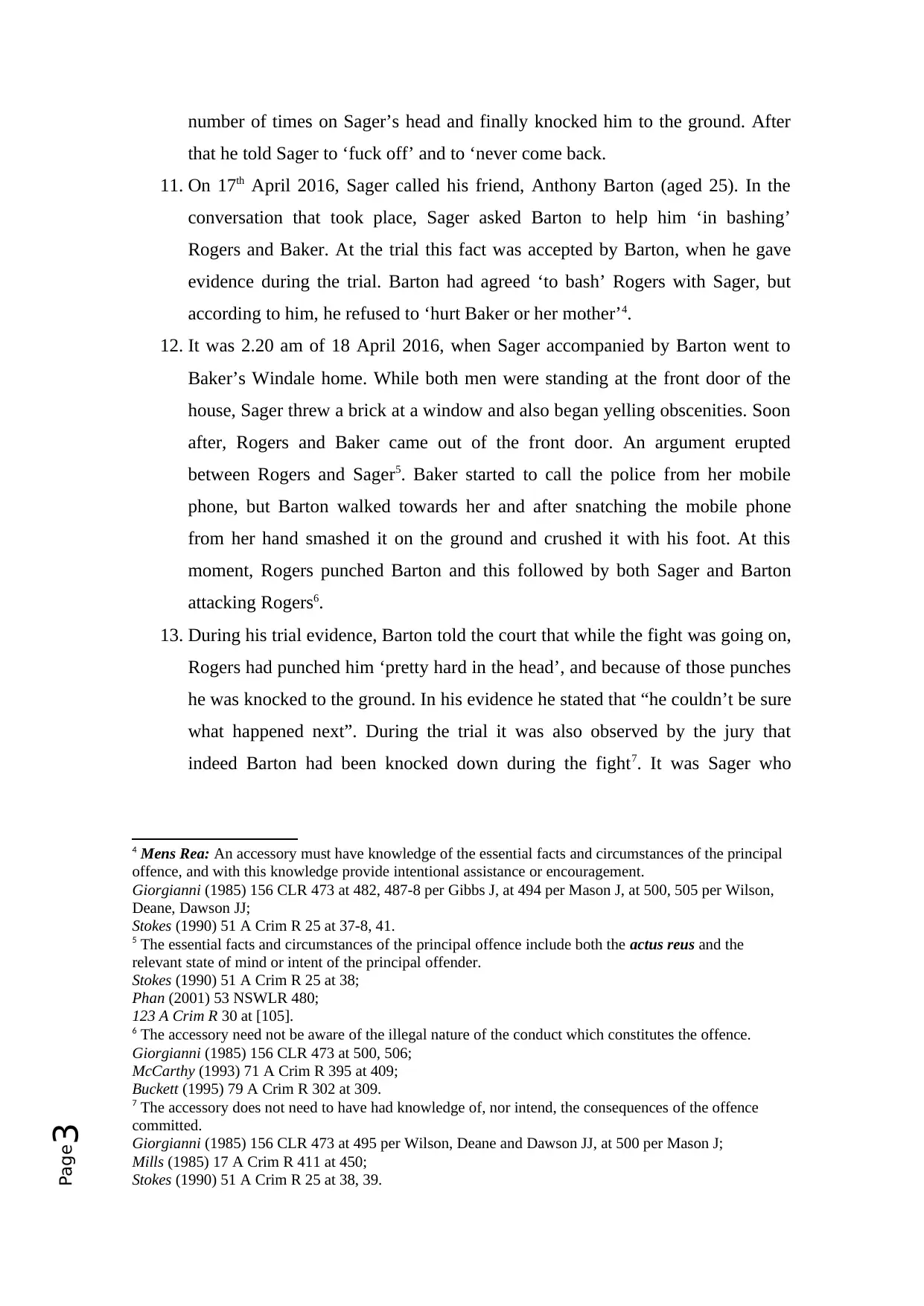
Page3
number of times on Sager’s head and finally knocked him to the ground. After
that he told Sager to ‘fuck off’ and to ‘never come back.
11. On 17th April 2016, Sager called his friend, Anthony Barton (aged 25). In the
conversation that took place, Sager asked Barton to help him ‘in bashing’
Rogers and Baker. At the trial this fact was accepted by Barton, when he gave
evidence during the trial. Barton had agreed ‘to bash’ Rogers with Sager, but
according to him, he refused to ‘hurt Baker or her mother’4.
12. It was 2.20 am of 18 April 2016, when Sager accompanied by Barton went to
Baker’s Windale home. While both men were standing at the front door of the
house, Sager threw a brick at a window and also began yelling obscenities. Soon
after, Rogers and Baker came out of the front door. An argument erupted
between Rogers and Sager5. Baker started to call the police from her mobile
phone, but Barton walked towards her and after snatching the mobile phone
from her hand smashed it on the ground and crushed it with his foot. At this
moment, Rogers punched Barton and this followed by both Sager and Barton
attacking Rogers6.
13. During his trial evidence, Barton told the court that while the fight was going on,
Rogers had punched him ‘pretty hard in the head’, and because of those punches
he was knocked to the ground. In his evidence he stated that “he couldn’t be sure
what happened next”. During the trial it was also observed by the jury that
indeed Barton had been knocked down during the fight7. It was Sager who
4 Mens Rea: An accessory must have knowledge of the essential facts and circumstances of the principal
offence, and with this knowledge provide intentional assistance or encouragement.
Giorgianni (1985) 156 CLR 473 at 482, 487-8 per Gibbs J, at 494 per Mason J, at 500, 505 per Wilson,
Deane, Dawson JJ;
Stokes (1990) 51 A Crim R 25 at 37-8, 41.
5 The essential facts and circumstances of the principal offence include both the actus reus and the
relevant state of mind or intent of the principal offender.
Stokes (1990) 51 A Crim R 25 at 38;
Phan (2001) 53 NSWLR 480;
123 A Crim R 30 at [105].
6 The accessory need not be aware of the illegal nature of the conduct which constitutes the offence.
Giorgianni (1985) 156 CLR 473 at 500, 506;
McCarthy (1993) 71 A Crim R 395 at 409;
Buckett (1995) 79 A Crim R 302 at 309.
7 The accessory does not need to have had knowledge of, nor intend, the consequences of the offence
committed.
Giorgianni (1985) 156 CLR 473 at 495 per Wilson, Deane and Dawson JJ, at 500 per Mason J;
Mills (1985) 17 A Crim R 411 at 450;
Stokes (1990) 51 A Crim R 25 at 38, 39.
number of times on Sager’s head and finally knocked him to the ground. After
that he told Sager to ‘fuck off’ and to ‘never come back.
11. On 17th April 2016, Sager called his friend, Anthony Barton (aged 25). In the
conversation that took place, Sager asked Barton to help him ‘in bashing’
Rogers and Baker. At the trial this fact was accepted by Barton, when he gave
evidence during the trial. Barton had agreed ‘to bash’ Rogers with Sager, but
according to him, he refused to ‘hurt Baker or her mother’4.
12. It was 2.20 am of 18 April 2016, when Sager accompanied by Barton went to
Baker’s Windale home. While both men were standing at the front door of the
house, Sager threw a brick at a window and also began yelling obscenities. Soon
after, Rogers and Baker came out of the front door. An argument erupted
between Rogers and Sager5. Baker started to call the police from her mobile
phone, but Barton walked towards her and after snatching the mobile phone
from her hand smashed it on the ground and crushed it with his foot. At this
moment, Rogers punched Barton and this followed by both Sager and Barton
attacking Rogers6.
13. During his trial evidence, Barton told the court that while the fight was going on,
Rogers had punched him ‘pretty hard in the head’, and because of those punches
he was knocked to the ground. In his evidence he stated that “he couldn’t be sure
what happened next”. During the trial it was also observed by the jury that
indeed Barton had been knocked down during the fight7. It was Sager who
4 Mens Rea: An accessory must have knowledge of the essential facts and circumstances of the principal
offence, and with this knowledge provide intentional assistance or encouragement.
Giorgianni (1985) 156 CLR 473 at 482, 487-8 per Gibbs J, at 494 per Mason J, at 500, 505 per Wilson,
Deane, Dawson JJ;
Stokes (1990) 51 A Crim R 25 at 37-8, 41.
5 The essential facts and circumstances of the principal offence include both the actus reus and the
relevant state of mind or intent of the principal offender.
Stokes (1990) 51 A Crim R 25 at 38;
Phan (2001) 53 NSWLR 480;
123 A Crim R 30 at [105].
6 The accessory need not be aware of the illegal nature of the conduct which constitutes the offence.
Giorgianni (1985) 156 CLR 473 at 500, 506;
McCarthy (1993) 71 A Crim R 395 at 409;
Buckett (1995) 79 A Crim R 302 at 309.
7 The accessory does not need to have had knowledge of, nor intend, the consequences of the offence
committed.
Giorgianni (1985) 156 CLR 473 at 495 per Wilson, Deane and Dawson JJ, at 500 per Mason J;
Mills (1985) 17 A Crim R 411 at 450;
Stokes (1990) 51 A Crim R 25 at 38, 39.
⊘ This is a preview!⊘
Do you want full access?
Subscribe today to unlock all pages.

Trusted by 1+ million students worldwide
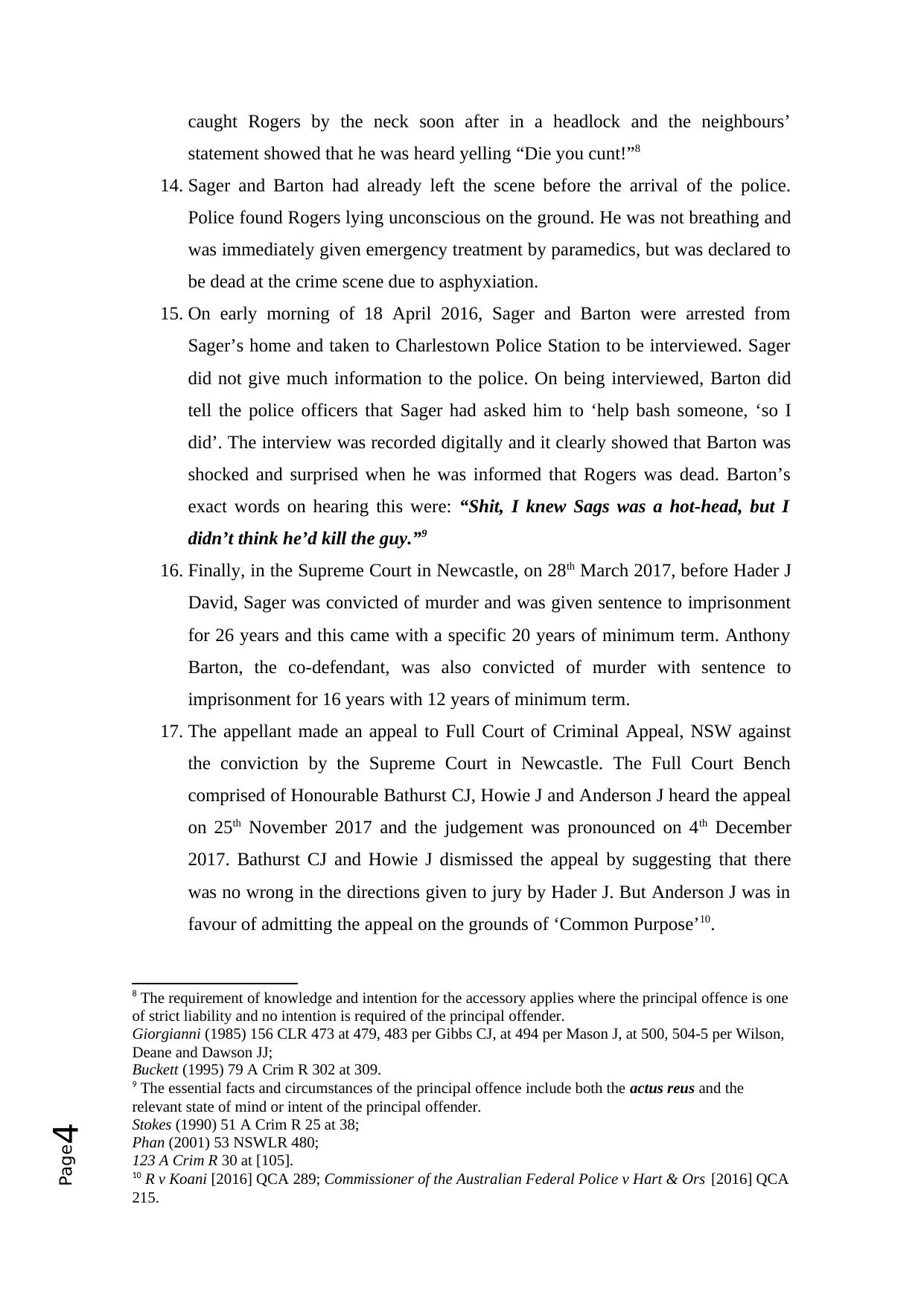
Page4
caught Rogers by the neck soon after in a headlock and the neighbours’
statement showed that he was heard yelling “Die you cunt!”8
14. Sager and Barton had already left the scene before the arrival of the police.
Police found Rogers lying unconscious on the ground. He was not breathing and
was immediately given emergency treatment by paramedics, but was declared to
be dead at the crime scene due to asphyxiation.
15. On early morning of 18 April 2016, Sager and Barton were arrested from
Sager’s home and taken to Charlestown Police Station to be interviewed. Sager
did not give much information to the police. On being interviewed, Barton did
tell the police officers that Sager had asked him to ‘help bash someone, ‘so I
did’. The interview was recorded digitally and it clearly showed that Barton was
shocked and surprised when he was informed that Rogers was dead. Barton’s
exact words on hearing this were: “Shit, I knew Sags was a hot-head, but I
didn’t think he’d kill the guy.”9
16. Finally, in the Supreme Court in Newcastle, on 28th March 2017, before Hader J
David, Sager was convicted of murder and was given sentence to imprisonment
for 26 years and this came with a specific 20 years of minimum term. Anthony
Barton, the co-defendant, was also convicted of murder with sentence to
imprisonment for 16 years with 12 years of minimum term.
17. The appellant made an appeal to Full Court of Criminal Appeal, NSW against
the conviction by the Supreme Court in Newcastle. The Full Court Bench
comprised of Honourable Bathurst CJ, Howie J and Anderson J heard the appeal
on 25th November 2017 and the judgement was pronounced on 4th December
2017. Bathurst CJ and Howie J dismissed the appeal by suggesting that there
was no wrong in the directions given to jury by Hader J. But Anderson J was in
favour of admitting the appeal on the grounds of ‘Common Purpose’10.
8 The requirement of knowledge and intention for the accessory applies where the principal offence is one
of strict liability and no intention is required of the principal offender.
Giorgianni (1985) 156 CLR 473 at 479, 483 per Gibbs CJ, at 494 per Mason J, at 500, 504-5 per Wilson,
Deane and Dawson JJ;
Buckett (1995) 79 A Crim R 302 at 309.
9 The essential facts and circumstances of the principal offence include both the actus reus and the
relevant state of mind or intent of the principal offender.
Stokes (1990) 51 A Crim R 25 at 38;
Phan (2001) 53 NSWLR 480;
123 A Crim R 30 at [105].
10 R v Koani [2016] QCA 289; Commissioner of the Australian Federal Police v Hart & Ors [2016] QCA
215.
caught Rogers by the neck soon after in a headlock and the neighbours’
statement showed that he was heard yelling “Die you cunt!”8
14. Sager and Barton had already left the scene before the arrival of the police.
Police found Rogers lying unconscious on the ground. He was not breathing and
was immediately given emergency treatment by paramedics, but was declared to
be dead at the crime scene due to asphyxiation.
15. On early morning of 18 April 2016, Sager and Barton were arrested from
Sager’s home and taken to Charlestown Police Station to be interviewed. Sager
did not give much information to the police. On being interviewed, Barton did
tell the police officers that Sager had asked him to ‘help bash someone, ‘so I
did’. The interview was recorded digitally and it clearly showed that Barton was
shocked and surprised when he was informed that Rogers was dead. Barton’s
exact words on hearing this were: “Shit, I knew Sags was a hot-head, but I
didn’t think he’d kill the guy.”9
16. Finally, in the Supreme Court in Newcastle, on 28th March 2017, before Hader J
David, Sager was convicted of murder and was given sentence to imprisonment
for 26 years and this came with a specific 20 years of minimum term. Anthony
Barton, the co-defendant, was also convicted of murder with sentence to
imprisonment for 16 years with 12 years of minimum term.
17. The appellant made an appeal to Full Court of Criminal Appeal, NSW against
the conviction by the Supreme Court in Newcastle. The Full Court Bench
comprised of Honourable Bathurst CJ, Howie J and Anderson J heard the appeal
on 25th November 2017 and the judgement was pronounced on 4th December
2017. Bathurst CJ and Howie J dismissed the appeal by suggesting that there
was no wrong in the directions given to jury by Hader J. But Anderson J was in
favour of admitting the appeal on the grounds of ‘Common Purpose’10.
8 The requirement of knowledge and intention for the accessory applies where the principal offence is one
of strict liability and no intention is required of the principal offender.
Giorgianni (1985) 156 CLR 473 at 479, 483 per Gibbs CJ, at 494 per Mason J, at 500, 504-5 per Wilson,
Deane and Dawson JJ;
Buckett (1995) 79 A Crim R 302 at 309.
9 The essential facts and circumstances of the principal offence include both the actus reus and the
relevant state of mind or intent of the principal offender.
Stokes (1990) 51 A Crim R 25 at 38;
Phan (2001) 53 NSWLR 480;
123 A Crim R 30 at [105].
10 R v Koani [2016] QCA 289; Commissioner of the Australian Federal Police v Hart & Ors [2016] QCA
215.
Paraphrase This Document
Need a fresh take? Get an instant paraphrase of this document with our AI Paraphraser
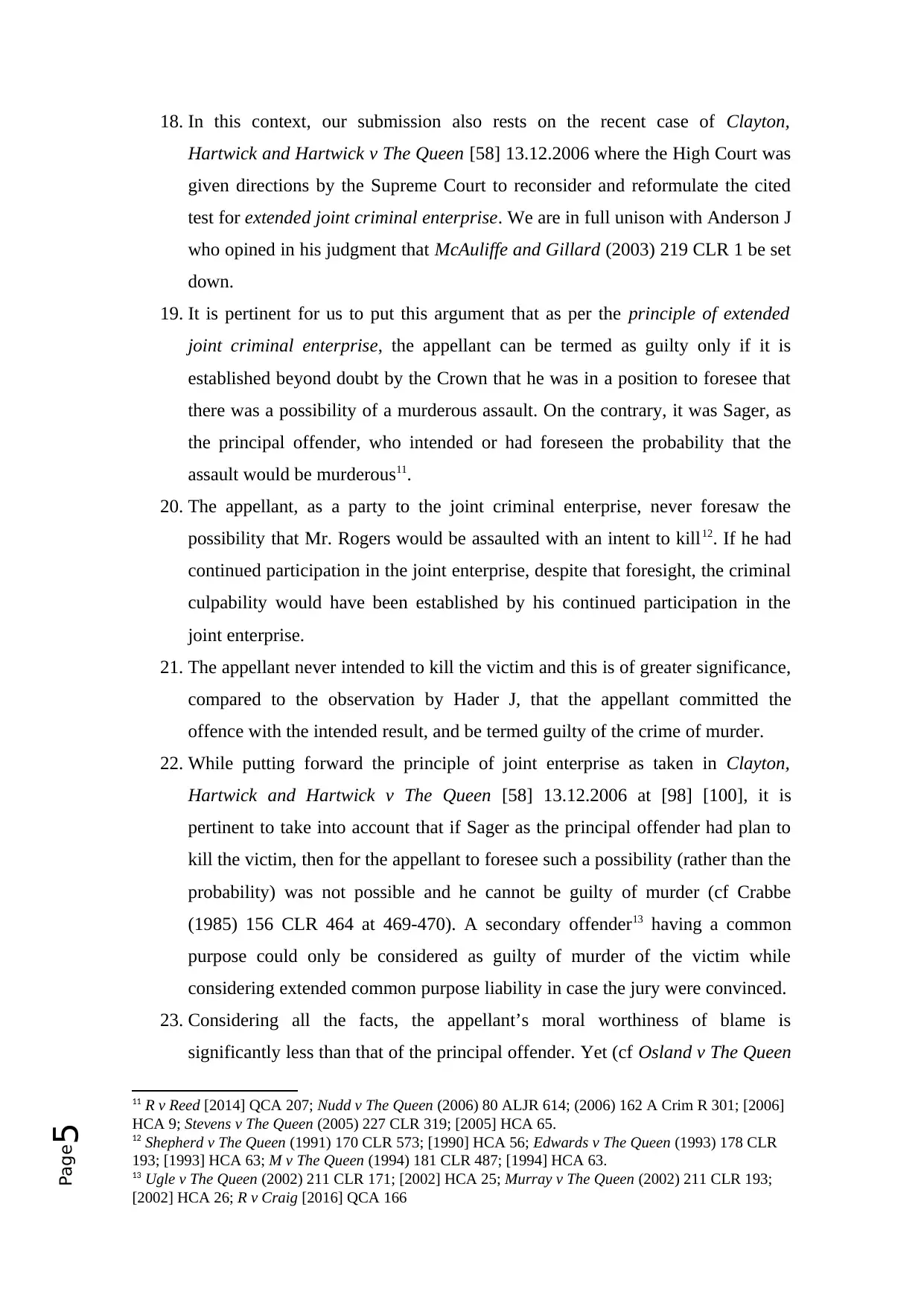
Page5
18. In this context, our submission also rests on the recent case of Clayton,
Hartwick and Hartwick v The Queen [58] 13.12.2006 where the High Court was
given directions by the Supreme Court to reconsider and reformulate the cited
test for extended joint criminal enterprise. We are in full unison with Anderson J
who opined in his judgment that McAuliffe and Gillard (2003) 219 CLR 1 be set
down.
19. It is pertinent for us to put this argument that as per the principle of extended
joint criminal enterprise, the appellant can be termed as guilty only if it is
established beyond doubt by the Crown that he was in a position to foresee that
there was a possibility of a murderous assault. On the contrary, it was Sager, as
the principal offender, who intended or had foreseen the probability that the
assault would be murderous11.
20. The appellant, as a party to the joint criminal enterprise, never foresaw the
possibility that Mr. Rogers would be assaulted with an intent to kill12. If he had
continued participation in the joint enterprise, despite that foresight, the criminal
culpability would have been established by his continued participation in the
joint enterprise.
21. The appellant never intended to kill the victim and this is of greater significance,
compared to the observation by Hader J, that the appellant committed the
offence with the intended result, and be termed guilty of the crime of murder.
22. While putting forward the principle of joint enterprise as taken in Clayton,
Hartwick and Hartwick v The Queen [58] 13.12.2006 at [98] [100], it is
pertinent to take into account that if Sager as the principal offender had plan to
kill the victim, then for the appellant to foresee such a possibility (rather than the
probability) was not possible and he cannot be guilty of murder (cf Crabbe
(1985) 156 CLR 464 at 469-470). A secondary offender13 having a common
purpose could only be considered as guilty of murder of the victim while
considering extended common purpose liability in case the jury were convinced.
23. Considering all the facts, the appellant’s moral worthiness of blame is
significantly less than that of the principal offender. Yet (cf Osland v The Queen
11 R v Reed [2014] QCA 207; Nudd v The Queen (2006) 80 ALJR 614; (2006) 162 A Crim R 301; [2006]
HCA 9; Stevens v The Queen (2005) 227 CLR 319; [2005] HCA 65.
12 Shepherd v The Queen (1991) 170 CLR 573; [1990] HCA 56; Edwards v The Queen (1993) 178 CLR
193; [1993] HCA 63; M v The Queen (1994) 181 CLR 487; [1994] HCA 63.
13 Ugle v The Queen (2002) 211 CLR 171; [2002] HCA 25; Murray v The Queen (2002) 211 CLR 193;
[2002] HCA 26; R v Craig [2016] QCA 166
18. In this context, our submission also rests on the recent case of Clayton,
Hartwick and Hartwick v The Queen [58] 13.12.2006 where the High Court was
given directions by the Supreme Court to reconsider and reformulate the cited
test for extended joint criminal enterprise. We are in full unison with Anderson J
who opined in his judgment that McAuliffe and Gillard (2003) 219 CLR 1 be set
down.
19. It is pertinent for us to put this argument that as per the principle of extended
joint criminal enterprise, the appellant can be termed as guilty only if it is
established beyond doubt by the Crown that he was in a position to foresee that
there was a possibility of a murderous assault. On the contrary, it was Sager, as
the principal offender, who intended or had foreseen the probability that the
assault would be murderous11.
20. The appellant, as a party to the joint criminal enterprise, never foresaw the
possibility that Mr. Rogers would be assaulted with an intent to kill12. If he had
continued participation in the joint enterprise, despite that foresight, the criminal
culpability would have been established by his continued participation in the
joint enterprise.
21. The appellant never intended to kill the victim and this is of greater significance,
compared to the observation by Hader J, that the appellant committed the
offence with the intended result, and be termed guilty of the crime of murder.
22. While putting forward the principle of joint enterprise as taken in Clayton,
Hartwick and Hartwick v The Queen [58] 13.12.2006 at [98] [100], it is
pertinent to take into account that if Sager as the principal offender had plan to
kill the victim, then for the appellant to foresee such a possibility (rather than the
probability) was not possible and he cannot be guilty of murder (cf Crabbe
(1985) 156 CLR 464 at 469-470). A secondary offender13 having a common
purpose could only be considered as guilty of murder of the victim while
considering extended common purpose liability in case the jury were convinced.
23. Considering all the facts, the appellant’s moral worthiness of blame is
significantly less than that of the principal offender. Yet (cf Osland v The Queen
11 R v Reed [2014] QCA 207; Nudd v The Queen (2006) 80 ALJR 614; (2006) 162 A Crim R 301; [2006]
HCA 9; Stevens v The Queen (2005) 227 CLR 319; [2005] HCA 65.
12 Shepherd v The Queen (1991) 170 CLR 573; [1990] HCA 56; Edwards v The Queen (1993) 178 CLR
193; [1993] HCA 63; M v The Queen (1994) 181 CLR 487; [1994] HCA 63.
13 Ugle v The Queen (2002) 211 CLR 171; [2002] HCA 25; Murray v The Queen (2002) 211 CLR 193;
[2002] HCA 26; R v Craig [2016] QCA 166
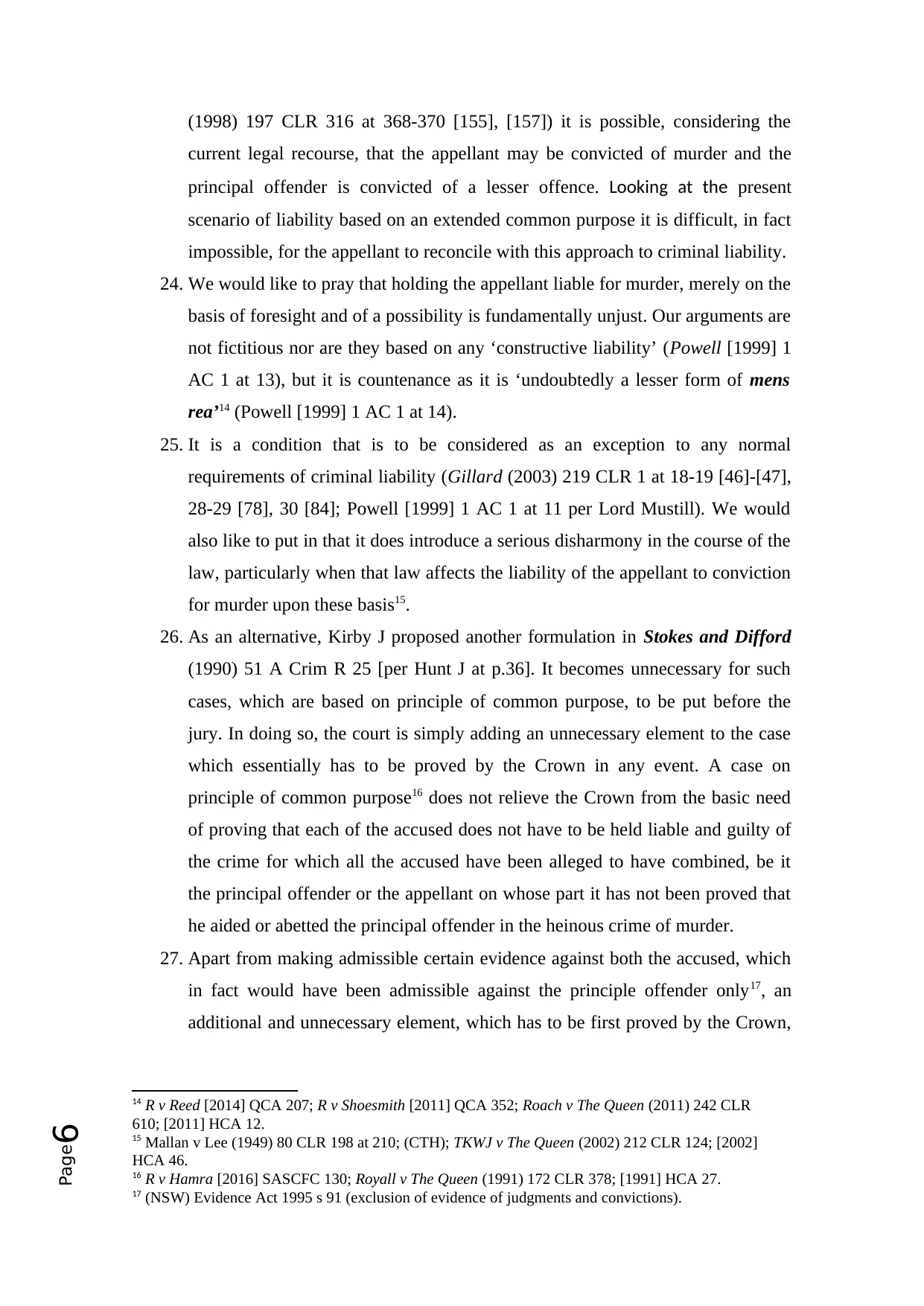
Page6
(1998) 197 CLR 316 at 368-370 [155], [157]) it is possible, considering the
current legal recourse, that the appellant may be convicted of murder and the
principal offender is convicted of a lesser offence. Looking at the present
scenario of liability based on an extended common purpose it is difficult, in fact
impossible, for the appellant to reconcile with this approach to criminal liability.
24. We would like to pray that holding the appellant liable for murder, merely on the
basis of foresight and of a possibility is fundamentally unjust. Our arguments are
not fictitious nor are they based on any ‘constructive liability’ (Powell [1999] 1
AC 1 at 13), but it is countenance as it is ‘undoubtedly a lesser form of mens
rea’14 (Powell [1999] 1 AC 1 at 14).
25. It is a condition that is to be considered as an exception to any normal
requirements of criminal liability (Gillard (2003) 219 CLR 1 at 18-19 [46]-[47],
28-29 [78], 30 [84]; Powell [1999] 1 AC 1 at 11 per Lord Mustill). We would
also like to put in that it does introduce a serious disharmony in the course of the
law, particularly when that law affects the liability of the appellant to conviction
for murder upon these basis15.
26. As an alternative, Kirby J proposed another formulation in Stokes and Difford
(1990) 51 A Crim R 25 [per Hunt J at p.36]. It becomes unnecessary for such
cases, which are based on principle of common purpose, to be put before the
jury. In doing so, the court is simply adding an unnecessary element to the case
which essentially has to be proved by the Crown in any event. A case on
principle of common purpose16 does not relieve the Crown from the basic need
of proving that each of the accused does not have to be held liable and guilty of
the crime for which all the accused have been alleged to have combined, be it
the principal offender or the appellant on whose part it has not been proved that
he aided or abetted the principal offender in the heinous crime of murder.
27. Apart from making admissible certain evidence against both the accused, which
in fact would have been admissible against the principle offender only17, an
additional and unnecessary element, which has to be first proved by the Crown,
14 R v Reed [2014] QCA 207; R v Shoesmith [2011] QCA 352; Roach v The Queen (2011) 242 CLR
610; [2011] HCA 12.
15 Mallan v Lee (1949) 80 CLR 198 at 210; (CTH); TKWJ v The Queen (2002) 212 CLR 124; [2002]
HCA 46.
16 R v Hamra [2016] SASCFC 130; Royall v The Queen (1991) 172 CLR 378; [1991] HCA 27.
17 (NSW) Evidence Act 1995 s 91 (exclusion of evidence of judgments and convictions).
(1998) 197 CLR 316 at 368-370 [155], [157]) it is possible, considering the
current legal recourse, that the appellant may be convicted of murder and the
principal offender is convicted of a lesser offence. Looking at the present
scenario of liability based on an extended common purpose it is difficult, in fact
impossible, for the appellant to reconcile with this approach to criminal liability.
24. We would like to pray that holding the appellant liable for murder, merely on the
basis of foresight and of a possibility is fundamentally unjust. Our arguments are
not fictitious nor are they based on any ‘constructive liability’ (Powell [1999] 1
AC 1 at 13), but it is countenance as it is ‘undoubtedly a lesser form of mens
rea’14 (Powell [1999] 1 AC 1 at 14).
25. It is a condition that is to be considered as an exception to any normal
requirements of criminal liability (Gillard (2003) 219 CLR 1 at 18-19 [46]-[47],
28-29 [78], 30 [84]; Powell [1999] 1 AC 1 at 11 per Lord Mustill). We would
also like to put in that it does introduce a serious disharmony in the course of the
law, particularly when that law affects the liability of the appellant to conviction
for murder upon these basis15.
26. As an alternative, Kirby J proposed another formulation in Stokes and Difford
(1990) 51 A Crim R 25 [per Hunt J at p.36]. It becomes unnecessary for such
cases, which are based on principle of common purpose, to be put before the
jury. In doing so, the court is simply adding an unnecessary element to the case
which essentially has to be proved by the Crown in any event. A case on
principle of common purpose16 does not relieve the Crown from the basic need
of proving that each of the accused does not have to be held liable and guilty of
the crime for which all the accused have been alleged to have combined, be it
the principal offender or the appellant on whose part it has not been proved that
he aided or abetted the principal offender in the heinous crime of murder.
27. Apart from making admissible certain evidence against both the accused, which
in fact would have been admissible against the principle offender only17, an
additional and unnecessary element, which has to be first proved by the Crown,
14 R v Reed [2014] QCA 207; R v Shoesmith [2011] QCA 352; Roach v The Queen (2011) 242 CLR
610; [2011] HCA 12.
15 Mallan v Lee (1949) 80 CLR 198 at 210; (CTH); TKWJ v The Queen (2002) 212 CLR 124; [2002]
HCA 46.
16 R v Hamra [2016] SASCFC 130; Royall v The Queen (1991) 172 CLR 378; [1991] HCA 27.
17 (NSW) Evidence Act 1995 s 91 (exclusion of evidence of judgments and convictions).
⊘ This is a preview!⊘
Do you want full access?
Subscribe today to unlock all pages.

Trusted by 1+ million students worldwide
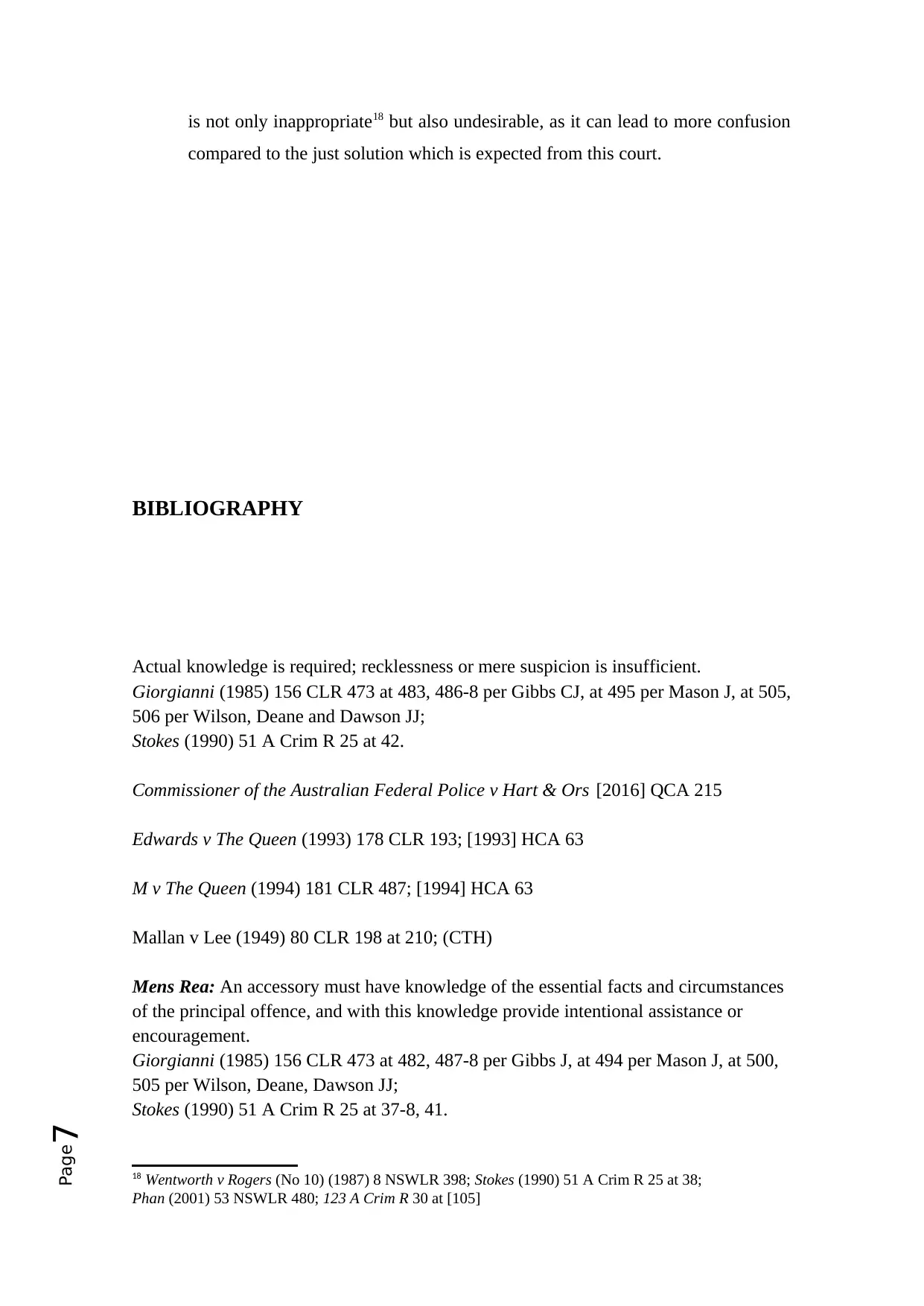
Page7
is not only inappropriate18 but also undesirable, as it can lead to more confusion
compared to the just solution which is expected from this court.
BIBLIOGRAPHY
Actual knowledge is required; recklessness or mere suspicion is insufficient.
Giorgianni (1985) 156 CLR 473 at 483, 486-8 per Gibbs CJ, at 495 per Mason J, at 505,
506 per Wilson, Deane and Dawson JJ;
Stokes (1990) 51 A Crim R 25 at 42.
Commissioner of the Australian Federal Police v Hart & Ors [2016] QCA 215
Edwards v The Queen (1993) 178 CLR 193; [1993] HCA 63
M v The Queen (1994) 181 CLR 487; [1994] HCA 63
Mallan v Lee (1949) 80 CLR 198 at 210; (CTH)
Mens Rea: An accessory must have knowledge of the essential facts and circumstances
of the principal offence, and with this knowledge provide intentional assistance or
encouragement.
Giorgianni (1985) 156 CLR 473 at 482, 487-8 per Gibbs J, at 494 per Mason J, at 500,
505 per Wilson, Deane, Dawson JJ;
Stokes (1990) 51 A Crim R 25 at 37-8, 41.
18 Wentworth v Rogers (No 10) (1987) 8 NSWLR 398; Stokes (1990) 51 A Crim R 25 at 38;
Phan (2001) 53 NSWLR 480; 123 A Crim R 30 at [105]
is not only inappropriate18 but also undesirable, as it can lead to more confusion
compared to the just solution which is expected from this court.
BIBLIOGRAPHY
Actual knowledge is required; recklessness or mere suspicion is insufficient.
Giorgianni (1985) 156 CLR 473 at 483, 486-8 per Gibbs CJ, at 495 per Mason J, at 505,
506 per Wilson, Deane and Dawson JJ;
Stokes (1990) 51 A Crim R 25 at 42.
Commissioner of the Australian Federal Police v Hart & Ors [2016] QCA 215
Edwards v The Queen (1993) 178 CLR 193; [1993] HCA 63
M v The Queen (1994) 181 CLR 487; [1994] HCA 63
Mallan v Lee (1949) 80 CLR 198 at 210; (CTH)
Mens Rea: An accessory must have knowledge of the essential facts and circumstances
of the principal offence, and with this knowledge provide intentional assistance or
encouragement.
Giorgianni (1985) 156 CLR 473 at 482, 487-8 per Gibbs J, at 494 per Mason J, at 500,
505 per Wilson, Deane, Dawson JJ;
Stokes (1990) 51 A Crim R 25 at 37-8, 41.
18 Wentworth v Rogers (No 10) (1987) 8 NSWLR 398; Stokes (1990) 51 A Crim R 25 at 38;
Phan (2001) 53 NSWLR 480; 123 A Crim R 30 at [105]
Paraphrase This Document
Need a fresh take? Get an instant paraphrase of this document with our AI Paraphraser
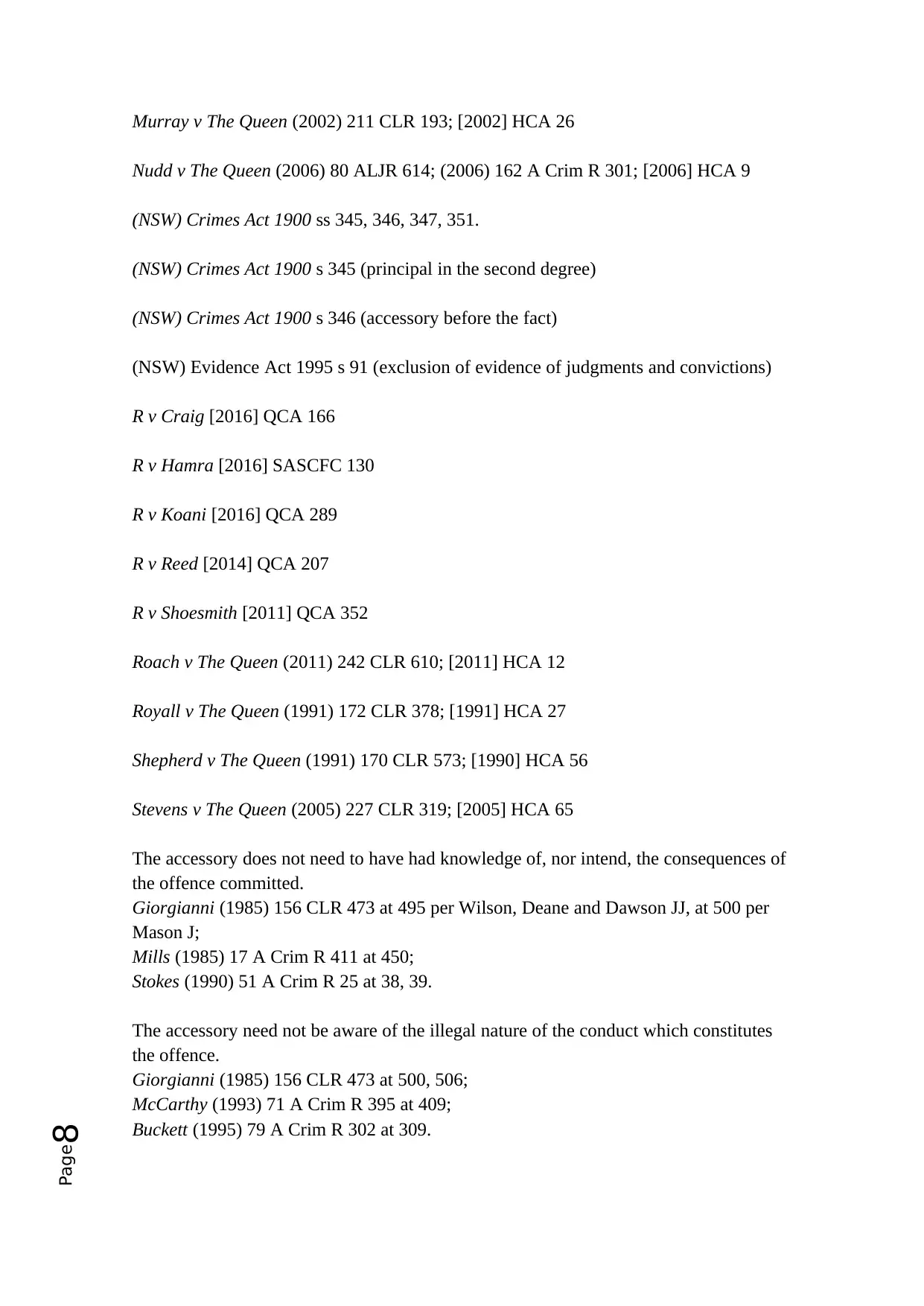
Page8
Murray v The Queen (2002) 211 CLR 193; [2002] HCA 26
Nudd v The Queen (2006) 80 ALJR 614; (2006) 162 A Crim R 301; [2006] HCA 9
(NSW) Crimes Act 1900 ss 345, 346, 347, 351.
(NSW) Crimes Act 1900 s 345 (principal in the second degree)
(NSW) Crimes Act 1900 s 346 (accessory before the fact)
(NSW) Evidence Act 1995 s 91 (exclusion of evidence of judgments and convictions)
R v Craig [2016] QCA 166
R v Hamra [2016] SASCFC 130
R v Koani [2016] QCA 289
R v Reed [2014] QCA 207
R v Shoesmith [2011] QCA 352
Roach v The Queen (2011) 242 CLR 610; [2011] HCA 12
Royall v The Queen (1991) 172 CLR 378; [1991] HCA 27
Shepherd v The Queen (1991) 170 CLR 573; [1990] HCA 56
Stevens v The Queen (2005) 227 CLR 319; [2005] HCA 65
The accessory does not need to have had knowledge of, nor intend, the consequences of
the offence committed.
Giorgianni (1985) 156 CLR 473 at 495 per Wilson, Deane and Dawson JJ, at 500 per
Mason J;
Mills (1985) 17 A Crim R 411 at 450;
Stokes (1990) 51 A Crim R 25 at 38, 39.
The accessory need not be aware of the illegal nature of the conduct which constitutes
the offence.
Giorgianni (1985) 156 CLR 473 at 500, 506;
McCarthy (1993) 71 A Crim R 395 at 409;
Buckett (1995) 79 A Crim R 302 at 309.
Murray v The Queen (2002) 211 CLR 193; [2002] HCA 26
Nudd v The Queen (2006) 80 ALJR 614; (2006) 162 A Crim R 301; [2006] HCA 9
(NSW) Crimes Act 1900 ss 345, 346, 347, 351.
(NSW) Crimes Act 1900 s 345 (principal in the second degree)
(NSW) Crimes Act 1900 s 346 (accessory before the fact)
(NSW) Evidence Act 1995 s 91 (exclusion of evidence of judgments and convictions)
R v Craig [2016] QCA 166
R v Hamra [2016] SASCFC 130
R v Koani [2016] QCA 289
R v Reed [2014] QCA 207
R v Shoesmith [2011] QCA 352
Roach v The Queen (2011) 242 CLR 610; [2011] HCA 12
Royall v The Queen (1991) 172 CLR 378; [1991] HCA 27
Shepherd v The Queen (1991) 170 CLR 573; [1990] HCA 56
Stevens v The Queen (2005) 227 CLR 319; [2005] HCA 65
The accessory does not need to have had knowledge of, nor intend, the consequences of
the offence committed.
Giorgianni (1985) 156 CLR 473 at 495 per Wilson, Deane and Dawson JJ, at 500 per
Mason J;
Mills (1985) 17 A Crim R 411 at 450;
Stokes (1990) 51 A Crim R 25 at 38, 39.
The accessory need not be aware of the illegal nature of the conduct which constitutes
the offence.
Giorgianni (1985) 156 CLR 473 at 500, 506;
McCarthy (1993) 71 A Crim R 395 at 409;
Buckett (1995) 79 A Crim R 302 at 309.
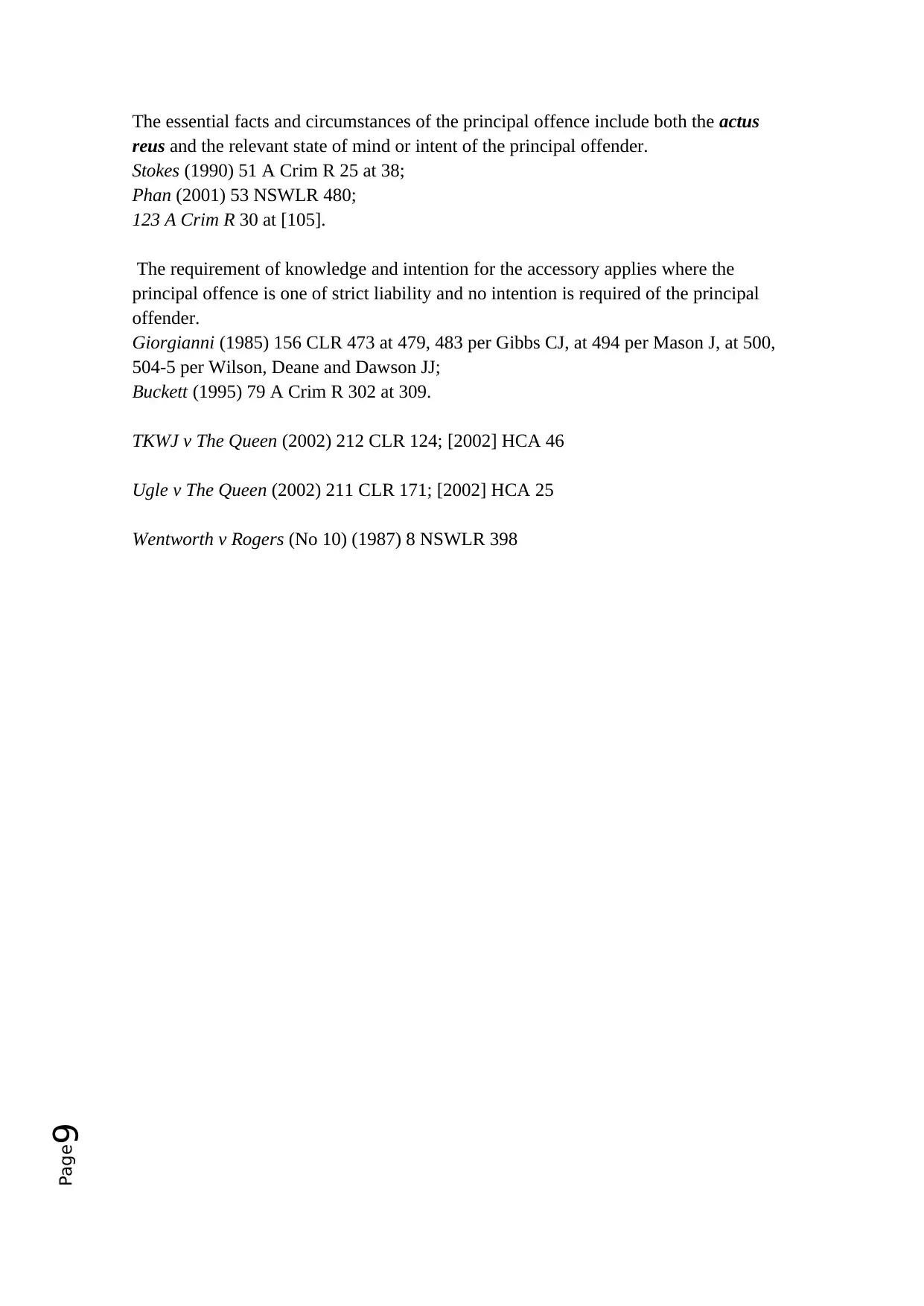
Page9
The essential facts and circumstances of the principal offence include both the actus
reus and the relevant state of mind or intent of the principal offender.
Stokes (1990) 51 A Crim R 25 at 38;
Phan (2001) 53 NSWLR 480;
123 A Crim R 30 at [105].
The requirement of knowledge and intention for the accessory applies where the
principal offence is one of strict liability and no intention is required of the principal
offender.
Giorgianni (1985) 156 CLR 473 at 479, 483 per Gibbs CJ, at 494 per Mason J, at 500,
504-5 per Wilson, Deane and Dawson JJ;
Buckett (1995) 79 A Crim R 302 at 309.
TKWJ v The Queen (2002) 212 CLR 124; [2002] HCA 46
Ugle v The Queen (2002) 211 CLR 171; [2002] HCA 25
Wentworth v Rogers (No 10) (1987) 8 NSWLR 398
The essential facts and circumstances of the principal offence include both the actus
reus and the relevant state of mind or intent of the principal offender.
Stokes (1990) 51 A Crim R 25 at 38;
Phan (2001) 53 NSWLR 480;
123 A Crim R 30 at [105].
The requirement of knowledge and intention for the accessory applies where the
principal offence is one of strict liability and no intention is required of the principal
offender.
Giorgianni (1985) 156 CLR 473 at 479, 483 per Gibbs CJ, at 494 per Mason J, at 500,
504-5 per Wilson, Deane and Dawson JJ;
Buckett (1995) 79 A Crim R 302 at 309.
TKWJ v The Queen (2002) 212 CLR 124; [2002] HCA 46
Ugle v The Queen (2002) 211 CLR 171; [2002] HCA 25
Wentworth v Rogers (No 10) (1987) 8 NSWLR 398
⊘ This is a preview!⊘
Do you want full access?
Subscribe today to unlock all pages.

Trusted by 1+ million students worldwide
1 out of 9
Your All-in-One AI-Powered Toolkit for Academic Success.
+13062052269
info@desklib.com
Available 24*7 on WhatsApp / Email
![[object Object]](/_next/static/media/star-bottom.7253800d.svg)
Unlock your academic potential
Copyright © 2020–2025 A2Z Services. All Rights Reserved. Developed and managed by ZUCOL.